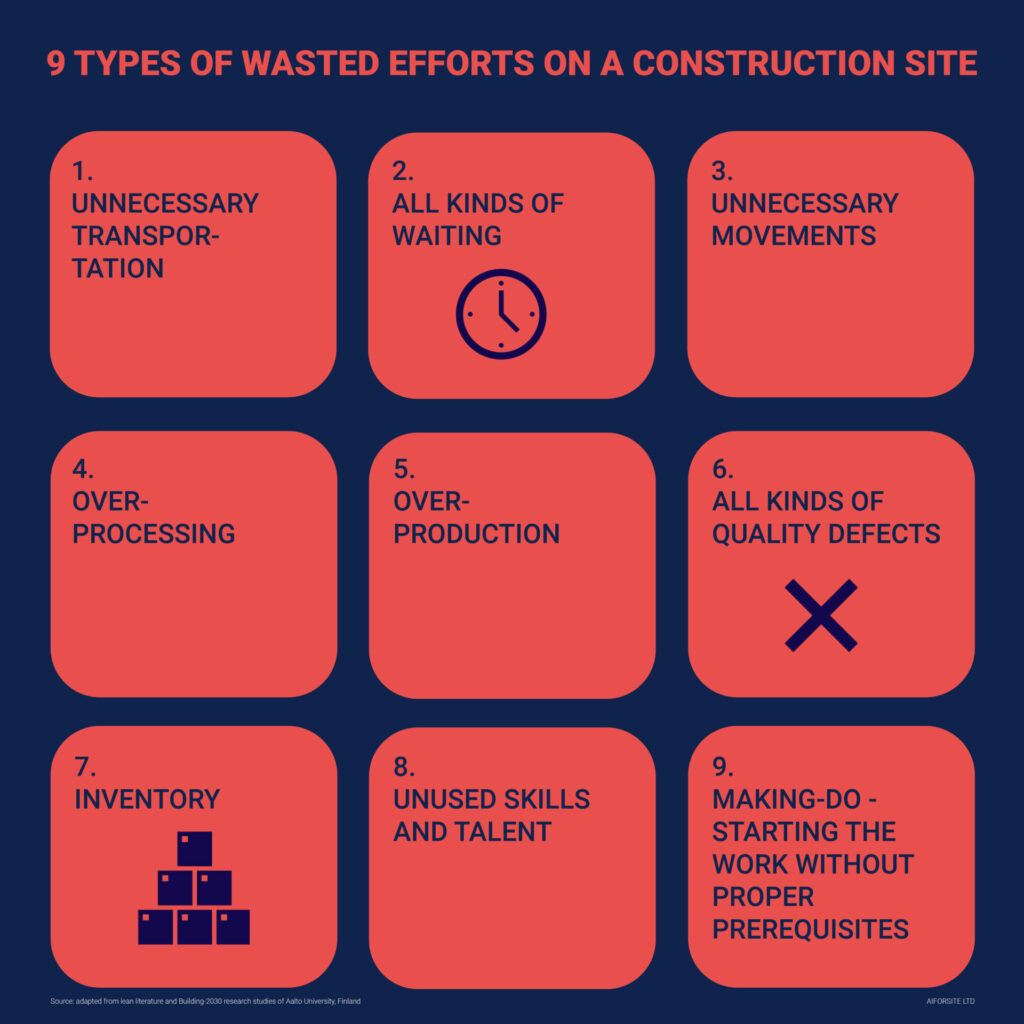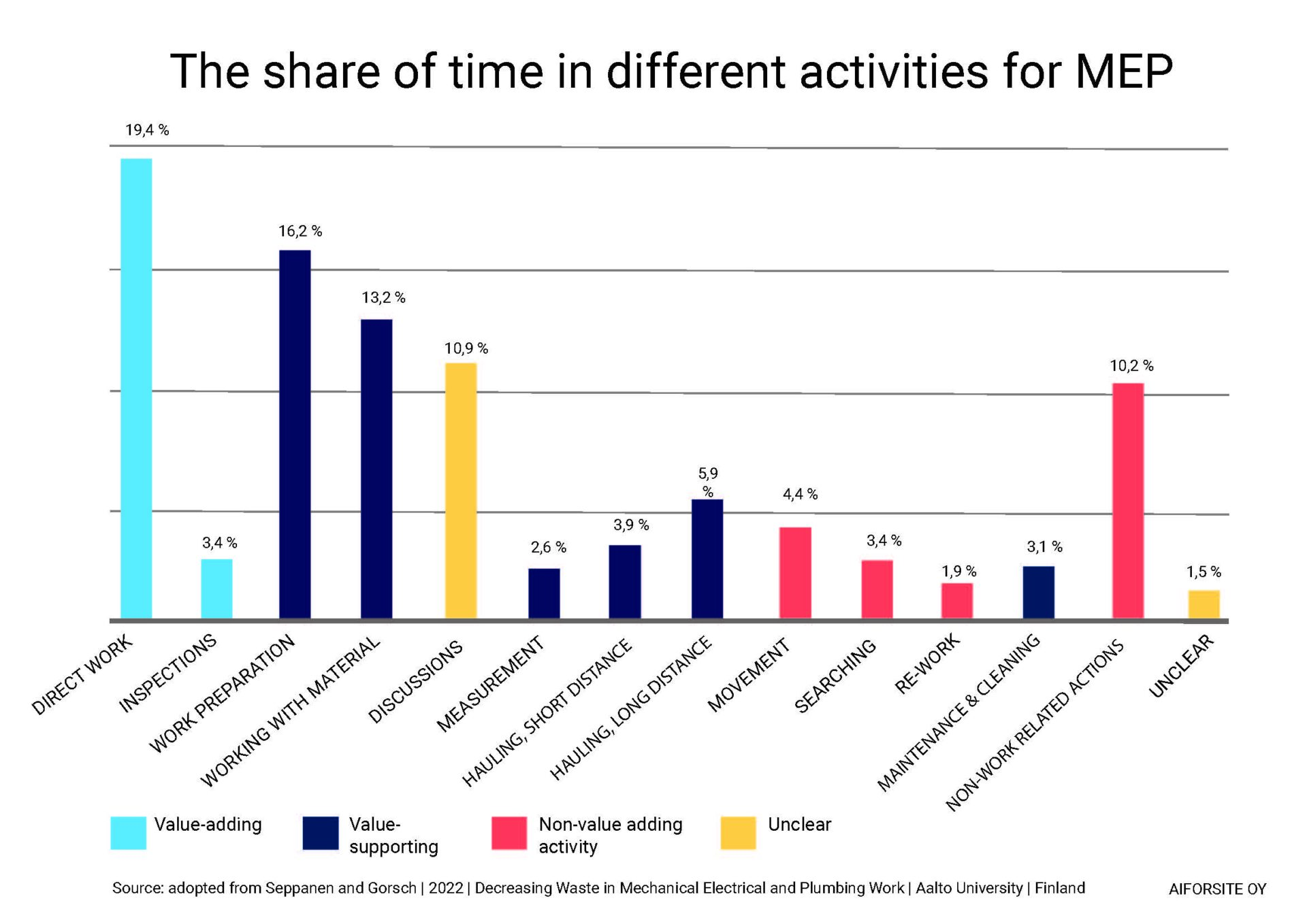Productivity research insights: Recent study on waste and productivity has revealed that almost 90 % of all wasted efforts in MEP works at a construction site are caused by missing prerequisites.
In 2021, Aalto University (Finland) studied the share of direct work, amount of wasted efforts and root causes in mechanical, electrical, and plumbing works. 15 MEP workers and foremen on four projects carried a helmet camera for one calendar week. Quantitative time-motion analysis was done based on these videos.
The study also utilised positioning data and resource tracking. All participants were interviewed, and video footage was reviewed together with the participants to evaluate the root causes of waste.
Direct work only 19.4%
The study revealed that direct work or installation time accounted for 24% of electrical work and 15% of plumbing work. Of the entire study, the direct work for MEP was 19.4%. The low proportion of the direct work was explained primarily by the challenges of material logistics in the plumbing work and the readiness of the previous tasks in the electrical work.
What is wasted effort in construction?
When speaking about waste in the working process, we mean anything that creates no value for the client or the contractor. The time spent on unnecessary activities is called wasted time or effort.
Waste has been categorised into several categories: overproduction, waiting, unnecessary transportation, unnecessary movements, over-processing, inventory, defects, and unused talent. In the construction context, the list also includes a waste of “making-do” – starting work without prerequisites.

The time spent on non-value-adding activities is of particular interest from the perspective of improving productivity.
Researchers used resource tracking technology to obtain data about time spent at each workspace. Researchers were particularly interested in installers’ long-term presences because work can only be productive if longer periods are spent at the workspace continuously (so-called uninterrupted presence).
Five root cases of wasted efforts identified
The root causes of wasted effort were poor communication, issues with production planning and control, uncoordinated design, poorly organised material flow and a high share of preparatory work steps.
The studied projects were all new construction and different in type and size – two residential sites, one office and one shopping centre project. The shopping centre project demonstrated the best direct work share. The project executed takt production even though it was the project with the least repetitive work and the largest distances due to the large floor area.
Missing prerequisites caused 90% of waste
Missing prerequisites could explain 90% of the wasted effort identified in the study. For example, the movement represented 53% of the waste observed, and missing prerequisites could explain 83% of the movement.

Waiting was 20% of wasted effort, and missing prerequisites were identified for 83% of waiting-related cases.
Also, waste types transportation (9%), defects (9%) and inventory (5%) were often associated with missing prerequisites. Delays in predecessor tasks led more often than other prerequisites to waiting, making-do and defects. Missing material rarely led to waiting but was seen mainly as movement, transportation and searching from storage areas. Missing design information led more often than other prerequisites to overprocessing (additional work steps), movement and defects.
Most of the missing prerequisites were related to missing materials or parts. Residential 1 had well-organised logistics, with materials on wheels, which can be seen in a smaller share of missing materials and equipment in that project.
All projects except the shopping centre suffered from many interruptions caused by preceding work. It indicates the benefits of takt production, which was used in the shopping centre but not in the other projects.

Installers’ time use
Researchers divided the installers’ time use into three main categories in the study:
- Value-adding
- Value-supporting
- Non-value-adding
| Value-adding 22, 8 % | Value-supporting 44,9 % | Non-value-adding 19,9 % |
| Installation (direct) work Inspections | Work preparation Measurement Hauling, short distance 5-30 m Hauling, long distance over 30 m Working with materials Maintenance & cleaning | Movement Searching Re-work Non-work related actions |

Value-adding work a total of 22.8%
Overall, the use of time was in line with the researchers’ expectations. The share of installation work as a whole, 19.4%, was on the same level as in previous studies (e.g. carpenters 21%, Pasila 2019). The share of inspections of 3.4% included all quality control measures that reduced re-work risk.
Value-supporting work almost 45%
Supporting activities such as hauling materials or working on the site are necessary for the convenient process. Still, even their share can be reduced by, for example, changing the division of tasks or increasing the degree of off-site construction.
Non-value-adding activities around 20%
This part included unnecessary movement or motions, searching for tools and materials, re-work, etc. Half of this part was non-work-related activities, such as waiting.
In addition, discussions and unclear cases were left unclassified. Their share was a total of 12.4%. The study did not count the number of conversations the installers had with each other and with other operators because the sound was not recorded. Ambiguous cases included tasks that could not be resolved, e.g. due to disturbances in the video or the wrong camera angle.
How can we improve the situation?
The researchers have introduced the following recommendations on how to improve the situation:
- Detailed MEP design and improved coordination
- Better logistics
- Increase share of off-site construction
- Better planning and control of works
- Better coordination in communications
We will discuss the recommendations in more detail in the next article.
Aiforsite’s solution helps reveal waste
Our technology makes waste visible. Quantitative, weekly-based monitoring and reporting keep site and project management up-to-date and schedules under control. Reduce waste and improve productivity with Aiforsite. Read more about our productivity engineer service.
